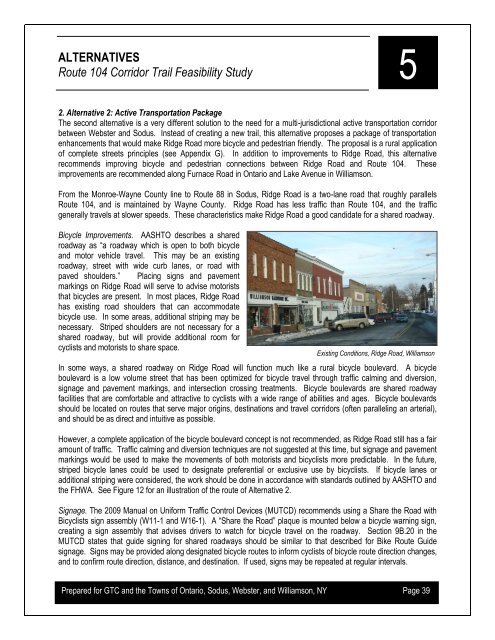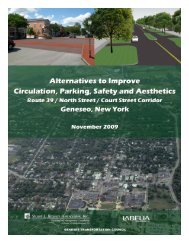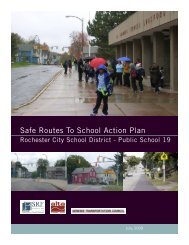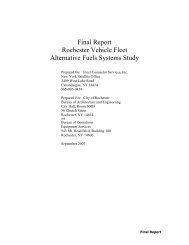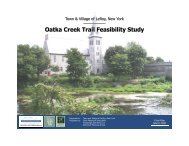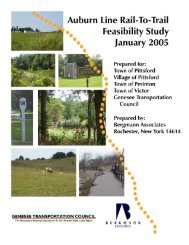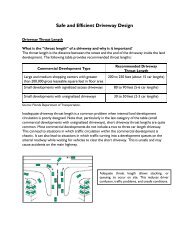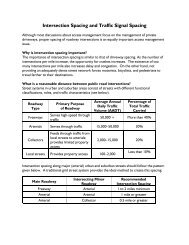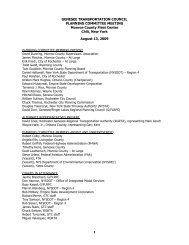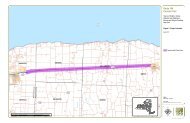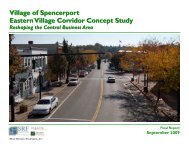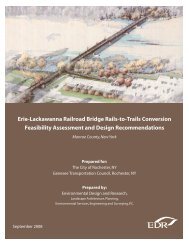Route 104 Corridor Trail Feasibility Study - Genesee Transportation ...
Route 104 Corridor Trail Feasibility Study - Genesee Transportation ...
Route 104 Corridor Trail Feasibility Study - Genesee Transportation ...
Create successful ePaper yourself
Turn your PDF publications into a flip-book with our unique Google optimized e-Paper software.
ALTERNATIVES<br />
5<br />
<strong>Route</strong> <strong>104</strong> <strong>Corridor</strong> <strong>Trail</strong> <strong>Feasibility</strong> <strong>Study</strong><br />
2. Alternative 2: Active <strong>Transportation</strong> Package<br />
The second alternative is a very different solution to the need for a multi-jurisdictional active transportation corridor<br />
between Webster and Sodus. Instead of creating a new trail, this alternative proposes a package of transportation<br />
enhancements that would make Ridge Road more bicycle and pedestrian friendly. The proposal is a rural application<br />
of complete streets principles (see Appendix G). In addition to improvements to Ridge Road, this alternative<br />
recommends improving bicycle and pedestrian connections between Ridge Road and <strong>Route</strong> <strong>104</strong>. These<br />
improvements are recommended along Furnace Road in Ontario and Lake Avenue in Williamson.<br />
From the Monroe-Wayne County line to <strong>Route</strong> 88 in Sodus, Ridge Road is a two-lane road that roughly parallels<br />
<strong>Route</strong> <strong>104</strong>, and is maintained by Wayne County. Ridge Road has less traffic than <strong>Route</strong> <strong>104</strong>, and the traffic<br />
generally travels at slower speeds. These characteristics make Ridge Road a good candidate for a shared roadway.<br />
Bicycle Improvements. AASHTO describes a shared<br />
roadway as ―a roadway which is open to both bicycle<br />
and motor vehicle travel. This may be an existing<br />
roadway, street with wide curb lanes, or road with<br />
paved shoulders.‖ Placing signs and pavement<br />
markings on Ridge Road will serve to advise motorists<br />
that bicycles are present. In most places, Ridge Road<br />
has existing road shoulders that can accommodate<br />
bicycle use. In some areas, additional striping may be<br />
necessary. Striped shoulders are not necessary for a<br />
shared roadway, but will provide additional room for<br />
cyclists and motorists to share space.<br />
Existing Conditions, Ridge Road, Williamson<br />
In some ways, a shared roadway on Ridge Road will function much like a rural bicycle boulevard. A bicycle<br />
boulevard is a low volume street that has been optimized for bicycle travel through traffic calming and diversion,<br />
signage and pavement markings, and intersection crossing treatments. Bicycle boulevards are shared roadway<br />
facilities that are comfortable and attractive to cyclists with a wide range of abilities and ages. Bicycle boulevards<br />
should be located on routes that serve major origins, destinations and travel corridors (often paralleling an arterial),<br />
and should be as direct and intuitive as possible.<br />
However, a complete application of the bicycle boulevard concept is not recommended, as Ridge Road still has a fair<br />
amount of traffic. Traffic calming and diversion techniques are not suggested at this time, but signage and pavement<br />
markings would be used to make the movements of both motorists and bicyclists more predictable. In the future,<br />
striped bicycle lanes could be used to designate preferential or exclusive use by bicyclists. If bicycle lanes or<br />
additional striping were considered, the work should be done in accordance with standards outlined by AASHTO and<br />
the FHWA. See Figure 12 for an illustration of the route of Alternative 2.<br />
Signage. The 2009 Manual on Uniform Traffic Control Devices (MUTCD) recommends using a Share the Road with<br />
Bicyclists sign assembly (W11-1 and W16-1). A ―Share the Road‖ plaque is mounted below a bicycle warning sign,<br />
creating a sign assembly that advises drivers to watch for bicycle travel on the roadway. Section 9B.20 in the<br />
MUTCD states that guide signing for shared roadways should be similar to that described for Bike <strong>Route</strong> Guide<br />
signage. Signs may be provided along designated bicycle routes to inform cyclists of bicycle route direction changes,<br />
and to confirm route direction, distance, and destination. If used, signs may be repeated at regular intervals.<br />
Prepared for GTC and the Towns of Ontario, Sodus, Webster, and Williamson, NY Page 39


